





Timber yards. 北海道 : 三井製材實况 [Hokkaido : Mitsui Seizai Shikyo] Mitsui & Co's Timber Industry in Hokkaido. Mitsui & Co [190-?]. 9x16cm publisher's colour printed card, cord tied. Contents leaf and 10 b/w photo postcards. The first four are joined to form a panorama of the Umaya Yard and another three form a panorama of the Sunagawa Mill. All have perforated edges for easy removal and the usual postcard stuff printed on the back. Cover a bit smudged, rather good. sold
It has always been a firm rule here to avoid postcards but as Sterne wrote somewhere, "Is a man to follow rules or rules to follow him?" The next question here is, who thought this was a good idea? Naturally we all want to see endless vistas of logs but do we want to send photos of them to our family and friends? But then, postcards were, in Japan, for collecting rather than sending.
Mitsui was and still is a gargantuan trading company though these days, according to their website, they are in the business of preserving forests. They still own 45,000 hectares of forest around Japan; my guess is that a lot more than that is stacked up here.
A long time ago I collected disaster souvenirs and remembering the souvenir views of the Hamburg cholera outbreak of 1892 this little book makes sense. It is, after all, progress and industry on a massive scale and the production is exemplary.







Building photograph. A large photograph of a large timber framed building and its builders during construction. n.p.n.d. [190-?]. Albumen print 21x27cm on embossed studio card mount 32x40cm, by Sugiura Photographic Studio in Matsumoto. Au$150
I'm told this came from Azumino City in Nagano Prefecture, not far from Matsumoto. The references to Sugiura photos from Azumino I've come across date from about 1890 to around 1914.
This is no quaint cottage or farmhouse, it looks like a modern school to me and I think it must be Unmei Gakko; it was at one stage with some later photos, also taken by Sugiura, of various special occasions - people but not the school building.
There were 35 people gathered on this wet day, not all of them workers by the look of it. There are a few distinguished older gentlemen at the front who might include school officials as well as the bosses. Doubtless they would soon put up their umbrellas and leave and the workers would get back to work.






Hirayama Shu. 最新飛行機図説 [Saishin Hikoki Zusetsu]. Toado Shoba 1911 (Meiji 44). 23x16cm publisher's cloth blocked in gilt, silver and blind (a bit used, small blotch on the front), remnants of the dustwrapper; two photo plates, numerous measured drawings. Some browning and smudges, used but acceptable. Au$200
First edition of this technical introduction and survey of the latest aeroplanes which might be the first proper Japanese aviation book. I found a couple of earlier popular books for kids but nothing serious. This was revised or checked by Hino Kumazo, almost the first Japanese aviator. A test flight in December 1910 was regarded more as jumps than flight and in the official attempt a few days later fellow pilot Tokugawa Yoshitoshi got first go. They had both been sent to France to learn to fly. Hino went on to develop his own aircraft and, later, a helicopter and a wingless jet propelled aircraft. None of them took off, so to speak.
I had trouble believing that Hirayama Shu is the same Hirayama Shu so closely associated with Sun Yat-Sen; surely he was too busy fomenting revolution at exactly this time. But Sun was in America for most of the year and Hino's preface speaks of his own long association with Hirayama and mentions their discussions about China.







Printing. 印刷大鑑 [Insatsu Taikan]. Osaka, Nihon Insatsu Kaisha 1915 (Taisho 4). Folio (39x27cm) publisher's patterned silk over bevelled boards with cord ties (silk worn through at the corners); 12 preliminary leaves including two colour plates and a preface in French, 96 specimen leaves by different printers on different papers is a variety of techniques: chromolithography, four colour process, photo engraving, gravure, embossing, etc, with two plates on metal sheets; 11 more leaves at the end including a couple of plates. Minor adhesion with a couple of the chromolithos, causing a tear on the facing leaf of one. Inner hinges have cracked at some time and repaired not so neatly. sold
A luxurious bit of showing off by the Japanese printing industry announcing that they have done their apprenticeship with western printers and now match them in skill. Fine printing, book work, advertising ... some kitsch and some very smart.
I now discover this exists in at least three states: one with silk covers and 101 specimens, this one with silk covers and 96 specimens, and one with mock silk printed boards with fewer preliminaries and 86 specimens. I presume this changed as specimens ran out. I've also realised that the cord ties are decorative: they are fastened under the endpapers in each cover and don't go through the book. Why I didn't notice this before ... I hang my head in shame.
For such a grand book this was not distributed as widely as you might expect. Worldcat finds five copies, all following the same catalogue entry dated 1916. I know that the two Australian copies are bound in silk and are dated 1915 and one US copy is the printed cover version; I don't know what the other two US copies are. CiNii finds five copies in Japanese libraries, and my searches of specialist libraries found no more.





Nurses. 記念写真帖 : 日本赤十字社 香川県 支部病院 1918. [Kinen Shashin Jo : Nihonsekijujisha Kagawa Shibu Byoin]. Takamatsu, Japanese Red Cross Society 1918 (Taisho 7]. 15x23cm publisher's colour printed wrapper, thread tied (one broken); 23 photo plates on 23 leaves, three pages of text and colophon leaf (ie 26 leaves). A bit used. Au$125
The nurses of Kagawa Prefecture Branch Hospital at work and at play towards the end of the work. It's hard to tell the difference between work and play but sober kimonos neatly arrayed around kotos must be play.






TAUT, Bruno. アルプス建築 [Arupusu Kenchiku] Alpine Architektur. Hagen, Folkwang 1919 [ie Tokyo, 1944]. 36x26cm publisher's flexible cloth and dustwrapper; title page in Japanese and 37 leaves consisting of 29 monochrome mounted leaves (title and contents leaves, five section titles and 22 plates) and eight colour lithographs. Covers chewed around the edges and along the spine, dustwrapper torn but pretty much all there. Usual browning of the uncoloured leaves. With the booklet containing the Japanese translation. Au$700
This might be the most curious Japanese book on western architecture. It's officially part of the collected works of Taut in Japanese (Tauto Zenshu) but while his other works were translated and collected into four solid sensible octavo volumes, here the original has been followed faithfully, lavishly. A translation was provided as an inserted booklet.
It has been sorted out thanks to the generous diligence of a librarian at the Art Institute of Chicago (the only library I could trace that had both versions) who, twice, compared them side by side and sent me a list of seven plates that vary in image size, that this isn't a re-issue of original sheets - once a common claim. So this is no photographic process reprint; the colour plates are proper colour lithographs that match the originals. While there's no doubt that elaborate and fine printing could be and was done in war time it still doesn't make sense. The flimsy translation booklet is what we expect from wartime printing - why not do a better job with that? The binding is war time, the printing is not.
So when were these plates produced? Were they prepared with Taut when he was in Japan - by 1936? The whole business of a collected edition of Taut in the middle of the war becomes something of a circular puzzle. Japan's ties with Germany are clear enough and the Japanese showed their appreciation of radical German modernists, or expressionists, like Taut and Mendelsohn pretty much even before Germany did, and Taut had spent years in Japan. But he was part of the exodus from Germany in 1933 and had died in Turkey in 1938. Still, a devoted band of fans did manage what seems unimaginable and got the job done.
Visionary, the term mostly used to describe this book, is often just another word for lunatic and Taut's utopian scheme for these monumental crystal structures marching across the mountain ranges of the world is captivatingly nutty. If this were to be judged on its own we would have just another eccentric, if endearing, relic of a dead end dream. But, in place in a cohesive group of theoretical writing and extensive design, both built and unbuilt, possible and impossible, this book wielded influence beyond its limited circulation in advancing the notion that, for the architect, principle, theory and social concern were tools as important as a T-square.

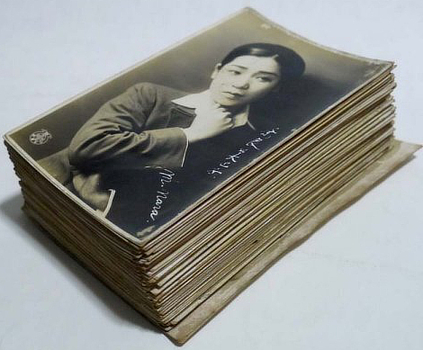
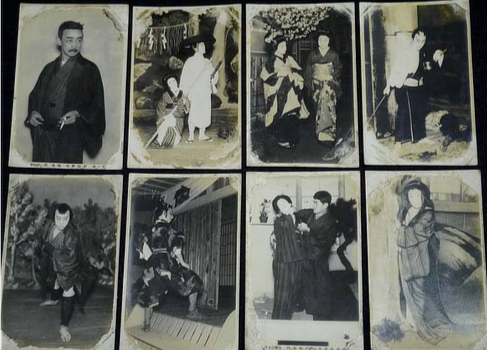
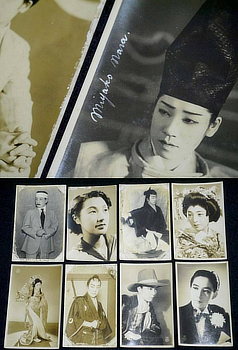


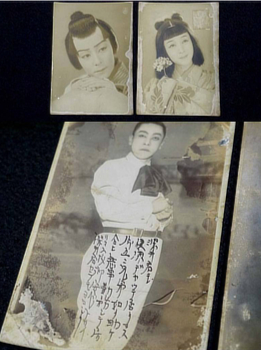

Takarazuka. A collection of 112 bromide photo postcards of Takarazuka actors n.p. c1920 to 30. These were obviously in an album with corners which have somehow interacted with the photo surface and caused bleaching and marks to corners and edges. There are three or four plain photos, the rest are postcards. Four have writing on the back and three are stamped. These are dated 1920. Au$500
The Takarazuka, the all women theatre company, was founded in 1913, presented their first show in 1914, introduced the revue to Japan in 1927, and is now, as much of the world knows, huge. There is a mountain of stuff out there but there is a paucity of images and information from their first years. A collection like this - the number of postcard photos - makes it evident that there was a well established fandom and a fair industry in satisfying them by the twenties, but not so much seems to have survived.
Sketchy and gap-toothed lists of actors are extant but most have no accompanying portraits; similarly sketchy lists of productions survive but even fewer are accompanied by photographs. I went through a decade of actors grouped by their first year assiduously collected on Takawiki expecting to find several examples of the same cards; I found one.
In later years actors became specialists, the otokoyaku play men, the musumeyaku play women, but our actors played men and women, Japanese and westerner, traditional and modern, gangster and empress. Nara Miyako, Kadota Ashiko and Ashihara Kuniko are identified; the rest are up to you. All are in costume and most are in action on stage.





墓標と記念碑 [Bohyo to Kinenhi]. Tokyo, Koyosha 1923 (Taisho 12). 19x13cm, loose as issued in publisher's printed boards; 50 leaves, mostly plates printed on one side. An excellent copy. Au$100
One of the apparently endless series of small architecture monographs, Kenchiku Shashin Riuju. I wonder if anyone knows how many there were. Some are intriguing and some are pretty drab. Many require a dogged love of gateways and tea rooms. This one is pretty good.
Gravestones and memorials, a good mix of old school kitsch and moderne, a few to the edge of extreme. They can be examples of pure design, being free and limitless, as the foreword says, and here are offered as a lesson to Japanese to reform their gloomy and sad approach to marking their dead in the landscape.







Ishimoto Kikuji. 建築譜 [Kenchikufu]. Bunriha Kenchikukai 1924 (Taisho 13) 27x20cm publisher's cloth backed boards blocked in black and gilt (cover browned); 14pp and 50 plates being a colour frontispiece and the rest b/w photos. A little browning or spotting at the very ends, quite a good copy. I am convinced that the inscription on the front fly begins with 日五 - day 5, the day this was published - and ends with 著者 - author. What comes in between ...? Au$1000
First edition; the architectural souvenirs of a trip to Europe and America by a founder of the Secessionist Architecture Group - Bunriha Kenchikukai. Germany is front and centre, if you haven't already spotted that from the cover. At the end of the preface he wonders whether to die for his principles like Gropius, indulge his hobbies like Poelzig, or dream like Taut. What he did in the end was found a firm that now builds massive projects that look like a thousand other buildings.
The radical architectural groups at this time were the Secessionists - formed in 1920 by six graduates of Tokyo Imperial University, growing to nine members - and the Barrack Decoration Company - formed by Kon Wajiro, Yoshida Kenkichi and a disparate group of designers and artists after the earthquake - who rushed around decorating the temporary buildings thrown up in the ruins. Parallel but further off was Mavo which also ran around improving barracks and makeshifts for a while. Naturally the purist Bunriha despised the Barrackists. Architecture could be art but artists could never be architects. Secessionist Takizawa was not so polite about it.







Art Galleries. 小規模の美術館 [Shokibo no Bijutsukan]. Tokyo, Koyosha 1924 (Taisho 13). 19x13cm, loose as issued in publisher's printed boards; 50 leaves, mostly plates - one double page plate carries two numbers - printed on one side; renderings, elevations and plans. Browning and signs of use, pretty decent. Au$250
One of the apparently endless series of small architecture monographs, Kenchiku Shashin Riuju. I wonder if anyone knows how many there were. Some are intriguing and some are pretty drab. Many require a dogged love of gateways and tea rooms. This one is up top.
Here are the three winners and six honourable mentions in a competition for a small scale art museum, or gallery, for any new but ambitious city - and there were a lot of them.
Worldcat finds no copies outside Japan.






Fireworks. 煙火競技大会 : 大正14年 : 栃木町消防組主宰 [Enka Kyogi Taikai : Taisho 14 : Tochigi-cho Shobo-gumi Shusai]. n.p. (1925, Taisho 14). 17x25 pattern cloth album, cord tied; 22 photos (11x15cm) on 11 heavy card leaves with captions, the last photo larger. sold
This album of the 1925 fireworks competition in Tochigi, then a town now a city, was put together by the town's fire chief. Note that there were day and night fireworks. Those large balls - shown with their maker and his apprentice during the festival and with the family in that last delightful photo - are called two shaku balls. A shaku is so close to a foot (12 inches) that it doesn't matter.







Fire sugoroku. 火防宣伝壽語録 [Hifuse Senden Kotobuki Goroku]. Nagano Prefecture, Hofukujimachi Shobo-gumi 1926 (Taisho 15). Colour broadside 80x55cm. A rather good copy with its original illustrated envelope. Au$650
A thrilling, vivid and rare game, bristling with peril and disaster, issued by the Hofukujimachi fire fighting department. I haven't found a record of another copy anywhere except here.






Fujimoto Katao. 実用お料理献立漫画双六 [Jitsuyo Oryori Kondate Manga Sugoroku]. Tokyo, Fujin Sekai 1926 (Taisho 15). Colour broadside 55x79cm. Mildly used, quite a good copy. Au$400
This delightful manga sugoroku celebrates cooking and was the new year gift from the magazine Woman's World.






Sunakawa Hoshiji. 少女ラヂオ放送双六 [Shojo Radjio Hoso Sugoroku]. Tokyo, Shojo Sekai 1926 (Taisho 15). Colour broadside 54x78cm. A couple of small holes in folds, quite a good copy. Au$600
The new year gift from the girl's magazine, Shojo Sekai, this is a celebration of radio: Japan's first radio station, JOAK in Tokyo, illustrated here, began broadcasting in March 1925. By the time readers got this game JOBK in Osaka and JOCK in Nagoya had made test broadcasts.
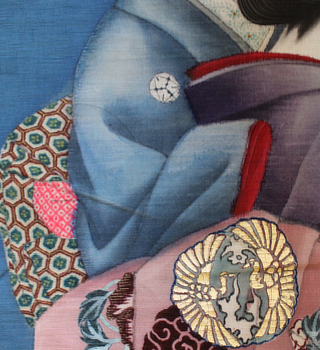
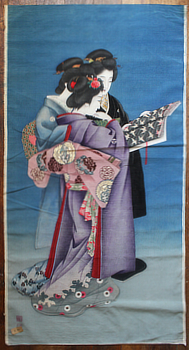
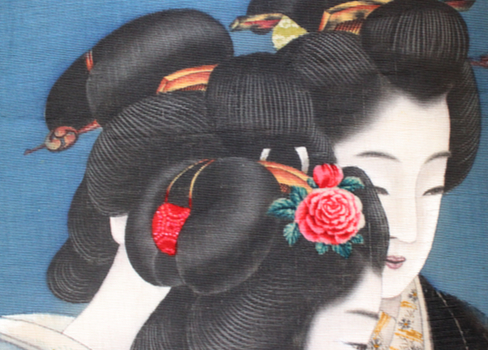
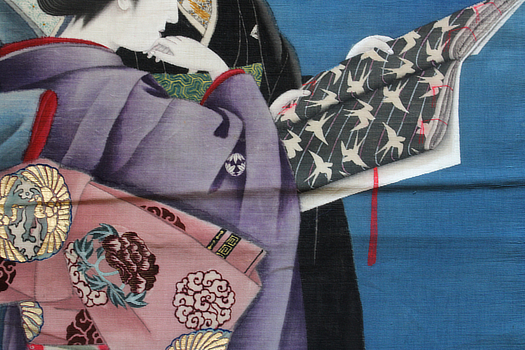
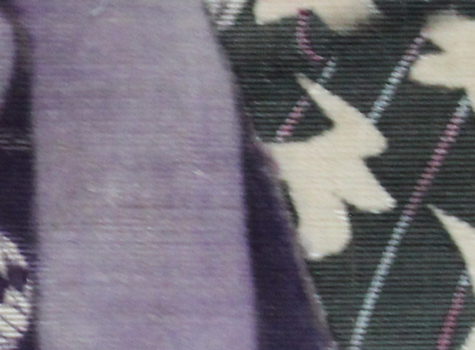
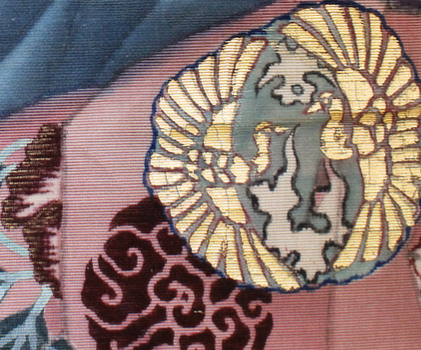
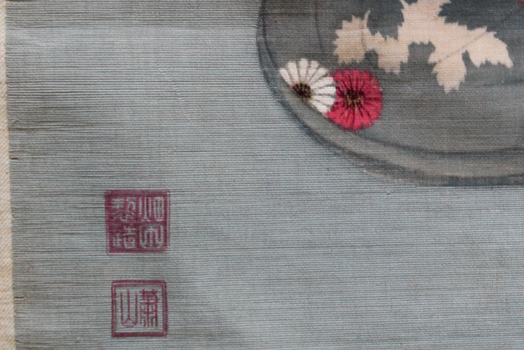

Kimono textile advertisement. Large painted advertisement on linen for a kimono textile merchant. n.p. [earlyish 20th century?]. 137x72cm painting on linen. Au$500
This extravagant promotional piece shows three exquisitely dressed and coiffed ladies considering a length of fabric. The woman with her back to us is undoubtedly the crucial judge.
I hope my photos convey some of the extraordinary detail: from the hair to the gold embroidery to the red thread that holds the bolt of cloth together. What I can't capture properly is the textures that have been mysteriously imbued into what is a heavy linen. That purple kimono feels like velvet, while next to it the horizontal ribbing is accentuated. If a ground has been applied it's microscopically thin. Has some additive to the colour softened and smoothed the fabric?
The upper seal in the bottom left corner includes 'Hatakeyama' I am told (after I read it backwards). I think the lower seal can translate as 'mountain spirit'. An allusive artist's name or establishment? I don't know. Any actual knowledge gratefully accepted.






Kon Wajiro 民俗と建築 : 平民工芸論 [Minzoku to Kenchiku : Heimin Kogeiron]. Tokyo, Isobe Koyodo 1927 (Showa 2). 19x13cm publisher's cloth and printed card slipcase (spine dulled); 115 illustrations, six folding. Name on the box. Au$150
First edition of Wajiro's collection of writings before and after the Kanto earthquake, charting his development from chronicler of folk architecture and crafts to modernologist. Minzoku to Kenchiku translates as folk customs and architecture so Kon warns in his preface that anyone expecting concrete architectural applications to current needs will be disappointed. Part four (of four) dates from the earthquake and is devoted to the makeshift shelters and barracks. Kon and an odd collection of designers, architects and designers formed the Barracks Decoration Company aiming to bring some vestiges of beauty, humanity and surprise to grim emergency sheds and shacks. From there it was a natural progression to modernology, the science of the present.